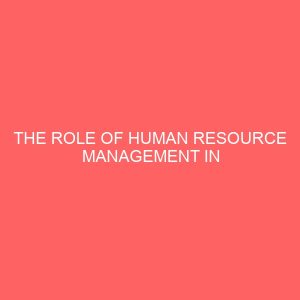Description
CHAPTER TWO
LITERATURE REVIEW
MOTIVATION DEFINED
According to Mathis, R.L and Jackson, J. H. (2006) Motivation is the desire within a person causing that person to act according to them, people usually act for one reason to reach a goal. Thus motivation is a goal directed, driven and as such, it seldom occurs in a void.
Weihrich, H and Kointz, H. (2005) defined motivation as a general term applying to the entire class of drive, desires, needs, wishes and similar forces. They are of the view that, says that manager motivate their subordinate do to say that they do things which they hope will satisfy these drives and induce the subordinate to act in a desired manner.
Cole, R. E (1995) also defined motivation as the term used to describe those processes, both instinctive and rational, by which people seek to satisfy the basic drives, perceived needs and personal goals, which trigger human behaviour.
Nwachukwu C. C. (2006) defined motivation as that energizing force that induces, compels, and maintain behaviour. Human behaviour is motivated and goal directed.
Although, all the definitions above have given a true picture of what motivation entails, but the most preferred definition from the researcher perspective is the one given below because of it more comprehensive components.
The researcher therefore will define motivation as a complex force, drives, tension, state or other mechanism that initiates and maintains voluntary activities, directed towards the achievement of goals.
THEORIES OF MOTIVATION
Mathis, and Jackson, (2006) posits that the two most discussed groups of theories are content and process theories.
i. CONTENT THEORIES OF MOTIVATION
Are theories that focus on the needs, drive or triggers of human behavious in a work place. Examples are:
a. Abraham Maslow’s Hierarchy of needs theory
b. Douglas McGregor – Theory X and theory Y
c. Herzberg Motivation – Hygiene theory
d. Mc Celland’s need theory
ii. PROCESS THEORIES OF MOTIVATION
Are those that try to explain and describe the process of how behaviour is energized, directed, sustained and finally stopped, that is how motivation occur. Examples are:
a. Expectancy theory
b. Equity theory
c. Re-enforcement theory
d. Attribution theory
e. Theory Z – The Japanese Approach
ABRAHAM MASLOW’S HIERARCHY OF NEEDS THEORY
One of the major and most widely recognized theories of motivation is the hierarchy of needs theory propounded by Abraham Maslow. Maslow’s studies into human motivation lead him to propose a theory of needs based on a hierarchical model with basic needs at bottom and higher needs at the top. This theory made a considerable influence on developments in management theory during the 1950s/60s due partly to the simplicity of the model and partly to the identification f higher level needs.
The starting point of Maslow’s hierarchy theory, first published in 1954, is that most people are motivated by the desire to satisfy specific groups of needs.
These needs are as follows:
a. Physiological Needs: This group needs include such things as food, water, clothing, shelter, sleep and sexual satisfaction. These are basic survival needs. These needs can be satisfied with money. A man who is starting life needs money to obtain shelter, buying food and clothing. His major pre-occupation will be to ensure that these basic needs are substantially satisfied.
b. Safety Needs: Here, Maslow is referring to safety of lives and properties; the needs to be free from physical danger and the fear of losing job, property, food, clothing and shelter. He posits that once this safety needs are satisfied minimally, it ceases to motivate and another level of motivation comes in.
c. Belonging and love needs: The gratification of the physiological and safety needs will give rise to the emergence of the need for affection and belongingness since human are social being they need to belong and to be accepted by others.
d. Esteem Needs: Once people begin to satisfy their needs to belong, they tend to want to be held in esteem both by themselves and by others. This kind of need produces such satisfaction as power, prestige, status and self confidence.
e. Self – Actualization: Maslow regards this need as the highest need on the hierarchy. They refer to man’s desire for self-fulfillment. It is the desire to become what one is capable of becoming to maximize one’s potential and to accomplish something.







